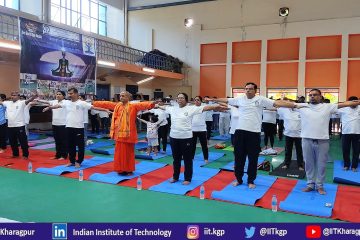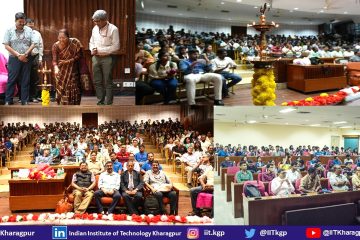
Prof. Abhijit Mukherjee, Dean international South Asia and Director, Curtin-India Academy, Curtin University, has been visiting IIT Kharagpur for the past five years with a team drawn from the top faculty of Curtin University who understand, as he does, the immense potential the Curtin University-IIT Kharagpur joint PhD programme holds out for both countries in the field of education, research and the betterment of human resources. Prof. Mukherjee is a civil engineer, researcher and educator. At the School of Civil and Mechanical Engineering, Curtin University, he has taught structural mechanics, structural design, structural stability and finite element analysis courses. His industrial consultations are on structural assessment, structural rehabilitation and new structural materials. He loves to work on rehabilitation of heritage structures.
 Prof. Mukherjee was in the IIT Kharagpur campus recently to attend the joint symposium of Curtin University-IIT Kharagpur and was mighty excited by what students, the real beneficiaries of the project, had to say about the programme at the symposium. Thrilled by the students’ accounts, he said, “The students are the best advertisement of the programme. They have made our job easy by coming out with such beautiful accounts of their experience at Curtin. “
Prof. Mukherjee was in the IIT Kharagpur campus recently to attend the joint symposium of Curtin University-IIT Kharagpur and was mighty excited by what students, the real beneficiaries of the project, had to say about the programme at the symposium. Thrilled by the students’ accounts, he said, “The students are the best advertisement of the programme. They have made our job easy by coming out with such beautiful accounts of their experience at Curtin. “
Prof. Mukherjee talked at length about his own experiences during the promotion of the joint PhD programme and what plans Curtin University has for the future.
Could you tell us about your association with IIT Kharagpur and the program you are promoting?
“I was a PhD student of IIT Kharapur from 1984-87 and have possibly come to IIT KGP every year after that… if not multiple times then at least once a year. But now it’s more of an official engagement where my present university, Curtin, has been working with IIT KGP for research partnership, especially the joint PhD programme. I am happy with the way the programme has developed. I would go on record in saying that IIT KGP students have great reputation on Curtin campus.”
Why is that?
In this case, it is a combination of academically superior quality but also the willingness to work hard. The students who come to us from IIT KGP spend about a year. The way they contribute to our research is fantastic. But at the same time, I have asked the students and they are extremely happy with what they gain from their experience in Curtin. It’s a win-win situation. Some of them have told me that they have learnt a completely different style of doing research… first grade way of doing research ethically and safely. These are some of the big takeaways. Students are wonderful raw materials and they get a very good polish when they go to Curtin.
When can we expect Curtin students to come here?
This is a joint degree programme and students can travel both ways. The first student in the programme came from Curtin to IIT KGP and not the other way around. Unfortunately, we have not been able to expand on that. No we have more students going to Curtin from IIT KGP. We are mindful of that imbalance and imbalance is something that Curtin University as a policy does not want to have. So we are taking a few measures so that more students come from Curtin to IIT KGP. One measure is to expand the programme from just PhD to other areas. We have signed an agreement to increase student mobility. Which means that now IIT KGP students can go to Curtin University without paying fees to Curtin and our students can come to IIT KGP without paying fees since they have paid to Curtin already at the time of registration.
The other programme is that IIT KGP’s top professors will go to Curtin and hold a workshop there. Once the students know the quality of research that happens at IIT KGP, they will automatically choose to come.
The other project still at the discussion level is that Curtin wants to start a global PhD where students will compulsorily go and work in other universities to do research. It happens in undergraduate level, we want it to happen in PhD programmes as well. And we feel that India is a wonderful destination. Remember Australia is a country of 25 million people. You cannot have the same impact that you have on 25 million on 1.3 billion people. (Laughs) That is why I, personally, as a researcher send my students regularly to India and China among many other countries.



